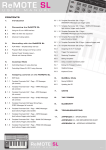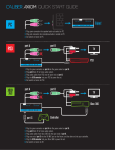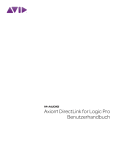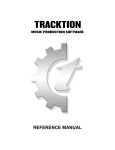Download Axiom DirectLink for Cubase User Guide
Transcript
Axiom DirectLink for Cubase User Guide ® Legal Notices This guide is copyrighted ©2010 by Avid Technology, Inc., with all rights reserved. Under copyright laws, this guide may not be duplicated in whole or in part without the written consent of Avid Technology, Inc. Avid, M-Audio and Axiom are either trademarks or registered trademarks of Avid Technology, Inc. All other trademarks contained herein are the property of their respective owners. Product features, specifications, system requirements, and availability are subject to change without notice. Guide Part Number 9329-65024-00 REV A 7/10 Documentation Feedback We are always looking for ways to improve our documentation. If you have comments, corrections, or suggestions regarding our documentation, email us at [email protected]. Contents Chapter 1. Introduction . . . . . . . . . . . . . . . . . . . . . . . . . . . . . . . . . . . . . . . . . . . . . . . . . . . . . . . . . . . . . . . . . . . . . . . . . . . 4 Chapter 2. Installation and Configuration . . . . . . . . . . . . . . . . . . . . . . . . . . . . . . . . . . . . . . . . . . . . . . . . . . . . . . . . . . 6 Chapter 3. Axiom Controls with DirectLink ........................................................7 Chapter 4. Instrument Mode . . . . . . . . . . . . . . . . . . . . . . . . . . . . . . . . . . . . . . . . . . . . . . . . . . . . . . . . . . . . . . . . . . . . . 12 Setting Up Instrument Mode . . . . . . . . . . . . . . . . . . . . . . . . . . . . . . . . . . . . . . . . . . . . . . . . . . . . . . . . . . . . . . . . . . . . 12 Using Instrument Mode . . . . . . . . . . . . . . . . . . . . . . . . . . . . . . . . . . . . . . . . . . . . . . . . . . . . . . . . . . . . . . . . . . . . . . . . 12 3 Contents Chapter 1: Introduction This guide covers DirectLink, which automatically maps Axiom® controls to common functions in Cubase 5 and later. DirectLink offers two-way communication with Cubase, featuring two distinct modes of operation with a level of integration that makes Axiom feel like a “dedicated” hardware controller. Once Cubase has been launched, DirectLink is activated in its default state which is Mixer Mode. In Mixer Mode, Axiom faders, buttons and knobs are mapped to Cubase mixer functions such as track and master channel volume, as well as the pan, track selection, mute, solo, and record arm, as explained in Chapter 3, “Axiom Controls with DirectLink.” Although Mixer mode provides effective control of the Cubase Mixer, Axiom DirectLink also gives you hands on control over any virtual instrument in your project. The first step towards controlling virtual instruments within your project is selecting a “target” track using the dedicated Track “<“ and “>” buttons. The target track determines which track Axiom will control. If there is a virtual instrument in the target track, pressing the Instrument button (Inst) instantly maps all Axiom controls to useful parameters on the instrument. Whenever DirectLink is switched to Instrument mode, the Instrument button will also illuminate to confirm that you are controlling an instrument. Pressing the Patch Up and Down buttons scrolls through patches to audition and select sounds in the targeted instrument. Pressing either of the Track buttons targets an adjacent track, allowing you to switch from one instrument to another. Pressing the Instrument button a second time returns Axiom to Mixer mode. While in Instrument Mode, holding down the Instrument button opens and closes the virtual instrument window. This lets you to see the on-screen controls update in real time as mapped Axiom controls are used. Instrument Mode has no affect on the Axiom Transport buttons, and they will remain mapped to their counterparts in Cubase. Although this introduction explains how DirectLink with Axiom can enhance your workflow, please take the time to read the rest of this User Guide. Combined with the Axiom User Guide, it will explain how to get the most out of your Axiom keyboard in Cubase. Axiom DirectLink for Cubase User Guide 4 Chapter 1: Introduction DirectLink Requirements System Requirements The latest system requirements can be found at www.m-audio.com. Cubase Software DirectLink requires Cubase version 5 or later. Earlier versions of Cubase do not support DirectLink. To learn more about upgrading your Cubase software, please visit http://www.steinberg.net. Axiom Drivers Windows users should download and install the latest Axiom drivers from www.m-audio.com/support if you are planning to do any or all of the following: • Control more than one application at the same time. • Simultaneously use other class-compliant USB audio devices. • Use long System Exclusive (SysEx) commands. For more information about Windows driver installation, and Axiom setup for both Mac and Windows, refer to the “Driver Installation” chapter of the Axiom User Guide. Axiom Hardware DirectLink requires that Axiom is connected to the host computer, and this guide assumes the process has already been completed. The installation and connection procedure is covered in the Axiom User Guide. A list of qualified recording applications, along with current Windows drivers, DirectLink installers and User Guides can be found at www.m-audio.com. Axiom DirectLink for Cubase User Guide 5 Chapter 1: Introduction Chapter 2: Installation and Configuration Before beginning the DirectLink installation, please make sure Axiom is connected to the host computer and that Cubase is not running. The instructions below will indicate when Cubase should be launched. To install DirectLink and configure Cubase: 1 Download the latest DirectLink installer for Cubase from www.m-audio.com/drivers. 2 Locate and double-click on the installer icon then follow the on-screen instructions. 3 Once the installation is complete, launch Cubase. 4 Navigate to the Devices menu > Device Setup. 5 Click on “+” in the upper right corner of the Device Setup dialog. 6 Choose “DirectLink.” 7 Select the Axiom DirectLink ports as the MIDI Input and MIDI Output. 8 Close the Device Setup dialog. 9 Axiom will be in DirectLink Mode and ready to control Cubase. Now, whenever Cubase is launched, DirectLink will activate automatically and map Axiom controls. Axiom DirectLink for Cubase User Guide 6 Chapter 2: Installation and Configuration Chapter 3: Axiom Controls with DirectLink 3 4 6 F E 1 7 E1 E2 E5 E3 E4 E6 E8 E7 2 204 F1 F2 F3 F4 F5 F6 Recall F7 F8 Ctrl Mute Panic Vel Lock F9 E9 12 F10 F11 F12 F13 F14 F15 F16 F17 Patch Mute Bank Solo E10 E11 E12 E13 E14 F18 Shift 5 Track 11 10 9 8 This chapter provides an overview of how Axiom controls function when controlling qualified versions of Cubase via DirectLink. Where applicable, both Mixer and Instrument Mode will be covered. 1 Shift Button This button is used to access alternate functions of the Faders, Encoder knobs, as well as the Mute and Track (< and >) buttons, as described later in this chapter. 2 Instrument Button (Inst) DirectLink offers two different modes of operation as described below. Mixer Mode This is the default DirectLink mode, in which Axiom Faders, Encoder knobs, and Fader buttons are mapped to their corresponding Cubase mixer functions. When a mapped Axiom control is used, its parameter assignment and numerical value will appear on the LCD screen. After one second the screen will revert to the track name. Pressing the Instrument button at any time switches Axiom controls to Instrument Mode. Instrument Mode Pressing the Instrument button (Inst) selects Instrument Mode. The LCD screen will momentarily display the name of the instrument being controlled, and then revert to the target track name. This maps Axiom Faders, Fader buttons, and Encoder knobs to instrument parameters within the target track in your Cubase project. The target track determines the destination of MIDI notes and control data transmitted from your Axiom keyboard. Axiom DirectLink for Cubase User Guide 7 Chapter 3: Axiom Controls with DirectLink When a mapped Axiom control is used, its parameter assignment and numerical value will appear on the LCD screen. After one second the screen will revert to the track name. Pressing the Instrument button again will return Axiom to Mixer Mode. While in Instrument Mode, holding down the Instrument button will open and close the active instrument window. Axiom Transport, Shift, Track select and Mute/Solo buttons are not affected by the Instrument button, and retain their assignments in both Mixer and Instrument Mode. 3 Group F Button (Axiom 49 and 61) The Group F button is illuminated by default, indicating that all nine Axiom faders and fader buttons (F1–18) are in DirectLink mode. When this button is pressed, it is no longer lit, and the faders and buttons are released from their DirectLink assignments, and mapped according to the active Patch. Pressing the Group F button again returns all controls to their DirectLink assignments. The button also illuminates confirming the group is in DirectLink Mode. 4 Faders Mixer Mode (Default) On Axiom 49 and 61, the first eight Faders (F1 – F8) control the track volume for the currently selected bank of eight tracks. The active bank (for example 1 – 8) is highlighted in white along the lower edge of the Cubase mixer, as shown in the following illustration. The right-most Fader (F9) and the single Fader on Axiom 25 will map to the Master Fader of the Cubase project. When an Axiom fader is moved, the current function or parameter assignment and its value will appear on the LCD screen. Instrument Mode The faders map to parameters on the virtual instrument within the target track. When an Axiom fader is moved, the current function or parameter assignment and its value will appear on the LCD screen. Moving an Axiom Fader while holding down the Shift button allows you to view or “peek” at its current parameter assignment and value. Axiom DirectLink for Cubase User Guide 8 Chapter 3: Axiom Controls with DirectLink 5 Fader Buttons Mixer Mode (Default) On Axiom 49 and 61, the first eight buttons (F10 – F17) map to the currently selected bank of eight tracks in Cubase, and by default each button targets its corresponding track when pressed. Pressing the right-most button (F18) switches buttons F10 – F17 to Mute mode. The LCD screen will display “Mute,” indicating the current mode of operation. Each button illuminates when pressed, and its corresponding track is muted. Pressing button F18 again switches buttons F10 – F17 to Solo mode, and the LCD screen will display “Solo.” Each button illuminates when pressed, and its corresponding track is soloed while all others are muted. Pressing F18 another time switches buttons F10 – F17 to Record Arm mode, and the LCD screen will display “Arm.” Each button illuminates when pressed, and its corresponding track is armed for recording. Instrument Mode Buttons F10 – F17 map to virtual instrument parameters within the target track. When a mapped Axiom button is pressed, the current function or parameter assignment will appear on the LCD screen. Fader button F18 will be lit while DirectLink is in Instrument mode. Pressing this button “flips” the faders and fader buttons back to Mixer mode, while the Encoders remain in Instrument mode. Pressing F18 a second time returns the faders and buttons to Instrument mode. 6 Group E Button The Group E button is illuminated by default, indicating that all eight Axiom Encoder knobs (E1–E8) are in DirectLink mode. When this button is pressed, it is no longer lit, and the knobs are released from their DirectLink assignments, and mapped according to the current active preset Patch. Pressing the Group E button again returns all controls to their DirectLink assignments. The button also illuminates confirming the group is in DirectLink Mode. Pressing the Group E button does not release the Axiom Transport buttons from DirectLink. 7 Encoder Knobs Mixer Mode On Axiom 49 and 61, the Encoder knobs (E1 – E8) control the Pan knobs in the Cubase Mixer. On Axiom 25 these knobs control the track volume for the currently selected bank of eight tracks. The LCD screen will display the current track name and Pan value whenever a knob is moved. Instrument Mode The Encoder knobs map to parameters on the virtual instrument within the target track. The LCD screen will display the current function or parameter assignment, as well as the current value whenever a knob is moved. Moving a control while holding down the Shift button allows you to view or “peek” at its current assignment and value. Axiom DirectLink for Cubase User Guide 9 Chapter 3: Axiom Controls with DirectLink 8 Transport Buttons In both Mixer and Instrument Modes, these buttons map to their corresponding buttons in Cubase and control the functions described below. Rewind - Holding this button rewinds the Cubase transport until the button is released. Momentarily pressing this button rewinds the transport one bar at a time. Fast Forward - Holding this button forwards the Cubase transport until the button is released. Momentarily pressing this button forwards the transport one bar at a time. Stop - This button stops playback or recording. Pressing this button twice skips to the beginning of the song, or the beginning of a looped section when Cubase is set to play or record in Cycle mode (See “Loop Play” button below). Play - This button starts playback or recording. Record - This button controls the Record button in the Cubase transport. Loop Play - Pressing the Loop button switches the transport Cycle function on and off. This function lets you either playback the song or record multiple takes between the Loop Start and End points specified in the Cubase transport. 9 Mute Button In both Mixer and Instrument mode the Mute button performs the following functions: • By default, pressing this button mutes the target track in a Cubase project. • Pressing this button while holding down the Shift button controls the Solo button for the Cubase track. 10 Track Buttons In both Mixer and Instrument Mode these buttons select the target track or bank of 8 tracks within a Cubase project. • Track Selection - The left Track button (<) targets the previous track in the project. For example, if Track 2 is currently targeted, pressing this button will target Track 1. The right Track button (>) targets the next track. For example, if Track 2 is currently targeted, pressing this button will target Track 3. The LCD screen will display the track name. If the target is an instrument track with a virtual instrument, it is armed for recording, and the instrument sound is heard when the keys are pressed. If Instrument Mode is active the controls will map to the instrument within the target track. These buttons can also be used to target tracks outside the currently active bank of 8 tracks. For example, if track 8 is currently targeted and the > Track button is pressed, Track 9 will be targeted. Axiom Faders and their corresponding buttons will now control Tracks 9 – 16. Axiom DirectLink for Cubase User Guide 10 Chapter 3: Axiom Controls with DirectLink • Bank Selection - When the Shift button is held down the left Track button (<) selects the previous bank of 8 tracks. For example, if the bank of Tracks 9 – 16 is currently selected, pressing this button when Shift is held down will select the bank of Tracks 1 – 8. The right Track button (>) selects the next bank of 8 tracks. For example, if the bank of Tracks 9 – 16 is currently selected, pressing this button when Shift is held down will select the bank of Tracks 17 – 24. 11 Zone Button This button is used for accessing the individual Zone buttons (1, 2, 3, and 4). Zones are used to split or layer the keyboard. When the Zone button is active, Shift, Track and Mute buttons will not function in DirectLink Mode. Pressing the Zone button returns these buttons to DirectLink. For more information, refer to Chapter 7, “Keyboard Zones” of the Axiom User Guide. 12 Patch Buttons These buttons are used for selecting virtual instrument sound patches when an active instrument window is open or hidden. Hiding an instrument window is not the same as closing it. Refer to the Cubase User Manual for more information about hiding instrument or plug-in windows. Axiom DirectLink for Cubase User Guide 11 Chapter 3: Axiom Controls with DirectLink Chapter 4: Instrument Mode Instrument Mode maps Axiom controls to numerous virtual instrument parameters within a targeted track in Cubase. This chapter provides an overview of how to setup and use DirectLink to control an instrument loaded into a track within a Cubase session. Setting Up Instrument Mode The following steps will guide you through setting up Instrument Mode. Please make sure Axiom is properly installed and connected to the host computer. To Set Up Instrument Mode: 1 Load a virtual instrument on to an Instrument track. Refer to the Cubase Reference Guide for more details. 2 Select the track using either the Fader buttons or the Track buttons. 3 Switch DirectLink to Instrument Mode by pressing the Instrument button (Inst). The button will illuminate, confirming that Axiom is in Instrument mode 4 Hold down the Instrument button to open the Instrument window. Using Instrument Mode Default Control Assignments for Cubase Instruments When DirectLink is switched to Instrument mode, Axiom control assignments within Cubase are defined by a default parameter list called a “VSTXML” file. This this file is provided by the instrument manufacturer and maps the Encoder knobs (E1 – E8) to parameters 1 – 8, the Faders (F1 – F8) to parameters 9 – 16, and the Master (F9) to parameter 25. Controlling Virtual Instruments Once an Instrument Track is targeted by Axiom and Instrument Mode is activated (See “Instrument Button (Inst)” on page 7), the instrument name will appear on the LCD screen. After 1 second the screen will display the track name. If the Track buttons (See “Track Buttons” on page 10) were used for targeting a track, it is also armed for recording, and notes are heard when the keys are pressed. Opening an Instrument Window Holding down the Instrument Mode will open the window for the virtual instrument being played. Instrument Preset Selection Sound patches within virtual instruments are selected using the Axiom Patch buttons. Axiom DirectLink for Cubase User Guide 12 Chapter 4: Instrument Mode Adjusting Instrument Parameters When a mapped Axiom control is moved its parameter assignment and numerical value will appear on the LCD screen. After 1 second the screen will revert the track name. Axiom controls can be returned to Mixer Mode, at any time, by pressing the Instrument button. Refer to Chapter 3, “Axiom Controls with DirectLink,” for more information about Axiom control types and their Instrument Mode functions. Axiom DirectLink for Cubase User Guide 13 Chapter 4: Instrument Mode Avid Technical Support (USA) Product Information 5795 Martin Road Irwindale, CA 91706-6211 USA Visit the Online Support Center at www.avid.com/support For company and product information, visit us on the web at www.avid.com
























